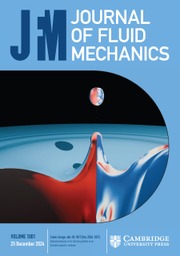Crossref Citations
This article has been cited by the following publications. This list is generated based on data provided by
Crossref.
Darelius, E.
and
Wåhlin, A.
2007.
Downward flow of dense water leaning on a submarine ridge.
Deep Sea Research Part I: Oceanographic Research Papers,
Vol. 54,
Issue. 7,
p.
1173.
Koshel, K V
Sokolovskiy, M A
and
Davies, P A
2008.
Chaotic advection and nonlinear resonances in an oceanic flow above submerged obstacle.
Fluid Dynamics Research,
Vol. 40,
Issue. 10,
p.
695.
Skogseth, R.
Smedsrud, L. H.
Nilsen, F.
and
Fer, I.
2008.
Observations of hydrography and downflow of brine‐enriched shelf water in the Storfjorden polynya, Svalbard.
Journal of Geophysical Research: Oceans,
Vol. 113,
Issue. C8,
Muench, R. D.
Wåhlin, A. K.
Özgökmen, T. M.
Hallberg, R.
and
Padman, L.
2009.
Impacts of bottom corrugations on a dense Antarctic outflow: NW Ross Sea.
Geophysical Research Letters,
Vol. 36,
Issue. 23,
Sokolovskiy, Mikhail A.
and
Verron, Jacques
2014.
Dynamics of Vortex Structures in a Stratified Rotating Fluid.
Vol. 47,
Issue. ,
p.
37.
Sokolovskiy, Mikhail A.
and
Verron, Jacques
2014.
Dynamics of Vortex Structures in a Stratified Rotating Fluid.
Vol. 47,
Issue. ,
p.
317.
Rebesco, Michele
Hernández-Molina, F. Javier
Van Rooij, David
and
Wåhlin, Anna
2014.
Contourites and associated sediments controlled by deep-water circulation processes: State-of-the-art and future considerations.
Marine Geology,
Vol. 352,
Issue. ,
p.
111.
Sokolovskiy, Mikhail A.
and
Verron, Jacques
2014.
Dynamics of Vortex Structures in a Stratified Rotating Fluid.
Vol. 47,
Issue. ,
p.
179.
Sokolovskiy, Mikhail A.
and
Verron, Jacques
2014.
Dynamics of Vortex Structures in a Stratified Rotating Fluid.
Vol. 47,
Issue. ,
p.
1.
Chiggiato, Jacopo
Bergamasco, Andrea
Borghini, Mireno
Falcieri, Francesco M.
Falco, Pierpaolo
Langone, Leonardo
Miserocchi, Stefano
Russo, Aniello
and
Schroeder, Katrin
2016.
Dense-water bottom currents in the Southern Adriatic Sea in spring 2012.
Marine Geology,
Vol. 375,
Issue. ,
p.
134.
Hernández-Molina, F. Javier
Wåhlin, Anna
Bruno, Miguel
Ercilla, Gemma
Llave, Estefanía
Serra, Nuno
Rosón, Gabriel
Puig, Pere
Rebesco, Michele
Van Rooij, David
Roque, David
González-Pola, César
Sánchez, Francisco
Gómez, María
Preu, Benedict
Schwenk, Tilmann
Hanebuth, Till J.J.
Sánchez Leal, Ricardo F.
García-Lafuente, Jesús
Brackenridge, Rachel E.
Juan, Carmen
Stow, Dorrik A.V.
and
Sánchez-González, José María
2016.
Oceanographic processes and morphosedimentary products along the Iberian margins: A new multidisciplinary approach.
Marine Geology,
Vol. 378,
Issue. ,
p.
127.
Vandorpe, T.
Martins, I.
Vitorino, J.
Hebbeln, D.
García, M.
and
Van Rooij, D.
2016.
Bottom currents and their influence on the sedimentation pattern in the El Arraiche mud volcano province, southern Gulf of Cadiz.
Marine Geology,
Vol. 378,
Issue. ,
p.
114.
Zhang, Wenyan
Hanebuth, Till J.J.
and
Stöber, Uwe
2016.
Short-term sediment dynamics on a meso-scale contourite drift (off NW Iberia): Impacts of multi-scale oceanographic processes deduced from the analysis of mooring data and numerical modelling.
Marine Geology,
Vol. 378,
Issue. ,
p.
81.
Wåhlin, A. K.
Steiger, N.
Darelius, E.
Assmann, K. M.
Glessmer, M. S.
Ha, H. K.
Herraiz-Borreguero, L.
Heuzé, C.
Jenkins, A.
Kim, T. W.
Mazur, A. K.
Sommeria, J.
and
Viboud, S.
2020.
Ice front blocking of ocean heat transport to an Antarctic ice shelf.
Nature,
Vol. 578,
Issue. 7796,
p.
568.
Drinkorn, Catherine
Saynisch-Wagner, Jan
Uenzelmann-Neben, Gabriele
and
Thomas, Maik
2021.
Decadal climate sensitivity of contouritic sedimentation in a dynamically coupled ice-ocean-sediment model of the North Atlantic.
Palaeogeography, Palaeoclimatology, Palaeoecology,
Vol. 572,
Issue. ,
p.
110391.


